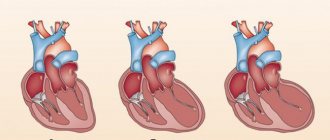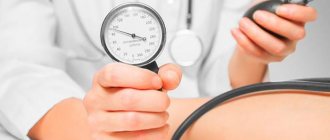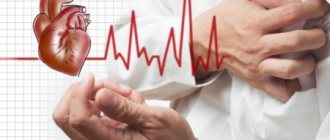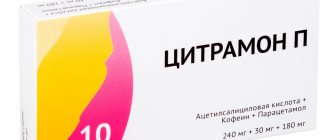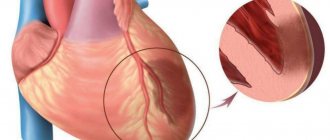How to recognize an impending heart attack
Doctors understand a heart attack as damage to the heart muscle caused by blockage of the heart artery and deterioration or complete cessation of blood supply to the organ. In such a situation, if the attack is not stopped and normal blood flow is not restored, myocardial tissue will begin to die 30 minutes after the first signs of a heart attack.
In addition to thrombosis of the artery, the attack occurs against the background of its spasm, stratification and penetration of a foreign body into the cavity of the capillary (for example, particles of a tumor). A heart attack is caused by various reasons, but the main ones are obesity, hypertension, heredity, smoking and alcoholism, diabetes, frequent stress, and lack of physical activity.
The risk of developing an attack is higher in people with elevated blood cholesterol levels, diseases of the cardiovascular system, and also after reaching 65–70 years of age. Specific signs of a heart attack include severe pain in the left side of the chest, prolonged signs of angina, panic attacks, cold sticky sweat and shortness of breath. The pain is burning in nature, and an attack of angina pectoris is not controlled by taking Nitroglycerin.
The attack can last two hours or drag on for a day, so at the first symptoms you need to seek medical help.
There are several types of heart attack:
- typical - its symptoms have already been described, it occurs in most cases;
- gastralgic – abdominal pain predominates, overshadowing other symptoms;
- asthmatic – manifested by severe suffocation;
- arrhythmic - it is characterized by a persistent change in the rhythm of heart contractions, which is life-threatening;
- cerebral - resembles a stroke, often occurs against the background of cardiogenic shock;
- asymptomatic - after suffering this type of heart attack, the victim can find out about it only during an ECG during a routine examination by a cardiologist.
It will probably be difficult or impossible to recognize an atypical heart attack on your own - a quarter of patients do not complain at all about squeezing and burning pain in the chest, which complicates timely diagnosis. The main problem with an asthma attack is that discomfort in the heart is masked as an asthma attack, which makes it difficult for doctors to immediately suspect a heart attack. When you press on the sternum and develop sharp pain, the diagnosis can speed up.
How long do they live after myocardial infarction? How long do they live after a heart attack?
Many people who have suffered a heart attack and their relatives are always interested in how long they live after a major myocardial infarction. Life expectancy depends on the quality and quantity of the consequences of the blow, the size of the lesion of the heart muscle, and the age of the patient.
To prolong your life as fully as possible after a heart attack, you need to take prescribed medications, lead a healthy lifestyle, and follow all medical recommendations. According to statistics, about 20% of patients live up to 5 years after a major attack.
The following consequences of myocardial infarction on humans can be distinguished:
Regular attacks of angina pectoris. An altered heartbeat is a reason to consult a cardiologist. Angina pectoris can bother the patient for a long time after an attack.
Microinfarction in men is a fairly common disease that can affect men over the age of 30
The symptoms of this attack are quite similar to many other diseases, so it is important to regularly visit a cardiologist and monitor your health
The consequences of a microinfarction are less dangerous for the body, but also require time for recovery. The main task in the case of a microinfarction is to recognize the attack in the initial stages.
Otherwise, a full-fledged heart attack may occur with more serious consequences. A microinfarction has its own specifics; some people may simply not notice it, but this does not mean a favorable result.
Prerequisites for microinfarction:
- Arrhythmia is an altered heartbeat, which is a serious reason to consult a doctor.
- Severe pain in the chest area for more than 20 minutes.
- Weakness, fatigue, anxiety
If you feel these symptoms, you should immediately seek help. After a full examination, the doctor will prescribe all specific recovery measures. Rehabilitation after a microinfarction is necessary in order to restore motor activity without any consequences.
Basic principles of recovery after a microinfarction:
- use of folk remedies;
- moderate physical activity;
- compliance with certain nutritional rules;
- timely visit to the doctor;
- lifestyle change.
Life after a myocardial infarction requires a lot of changes from a person. After an illness, not all work is allowed. You will have to limit physical activity, change your diet, constantly monitor your condition, adhere to all health measures prescribed by your doctor, and limit yourself in activity.
Whether life is possible after a heart attack largely depends on the patient himself. If he does not strictly follow the doctor’s recommendations for drug treatment and rehabilitation measures, then after a heart attack a number of complications may develop.
Pulse and pressure indicators during a heart attack
What pressure a victim will have during a myocardial infarction depends on his tonometer performance. If a person suffers from regular attacks of hypertension, there are two options for how events will develop. When a person’s working pressure constantly reaches the upper level of 160 mm Hg. Art., during a heart attack the tonometer can show the same amount. An increase in pressure is also possible, but it is not observed in all cases.
In the pre-infarction period, hypotensive patients are characterized by an increase in values up to 130/90 mm Hg. Art. while maintaining a normal pulse. It should be taken into account that it is wrong to rely only on the tonometer readings if you suspect a heart attack; there is a possibility that the pressure will remain within normal limits - it all depends on the person’s working blood pressure (BP). You can feel an increase in indicators at the time of an attack by sudden dizziness, increased heart rate, shortness of breath and a rush of blood to the face.
Can the pressure go down?
Can you have a heart attack with low blood pressure? Yes, because during an attack a painful shock develops, which is accompanied by collapse (this condition is characterized by pathological narrowing of blood vessels, including the brain, and a lack of oxygen supply). In such a situation, a person loses consciousness, and blood pressure drops sharply.
Low pressure readings with a rapid pulse indicate an increase in the Algover shock index - this aggravates the picture of the attack and often leads to death due to the centralization of the blood supply. Initially, the heartbeat simply increases, but then tachycardia with a decrease in cardiac output is replaced by uncontrolled contraction of the atria. Ventricular fibrillation develops, which is considered a life-threatening condition.
Why is a heart attack dangerous? Complications
During a heart attack, heart tissue is damaged and the following complications may develop:
- arrhythmia. The most common complication can develop immediately after a heart attack. Heart rhythm disturbances can lead to ventricular fibrillation, in which they contract uncoordinated, to ventricular tachycardia, in which the heart rate increases, etc.;
- heart failure. If a large volume of tissue is damaged, the heart muscle cannot pump blood in sufficient volume. The condition may be temporary. If the damage to the heart is irreversible, chronic heart failure develops;
- sudden cardiac arrest. Due to arrhythmia, the heart muscle suddenly stops. Without emergency help, this can lead to death.
Symptoms of an attack
Pressure during myocardial infarction in women increases or decreases, depending on the general health of the patient, the presence of excess weight, diseases of the cardiovascular system, hypertension and hypotension. It has been noted that heart attacks are less common in women, but due to the almost asymptomatic course of the attack, the number of deaths increases (it reaches 50%).
In most cases, specific signs do not appear, unlike in men; as a result, diagnosis is delayed and the risk of death increases. To prevent such a situation, you need to know what clinical picture is accompanied by an attack in women:
Causes of high blood pressure and high pulse
- dyspnea;
- feeling of acute lack of oxygen;
- neuralgic pain around the sternum;
- loss of orientation in space;
- dizziness;
- pain in the upper abdomen.
Why do pressure during a heart attack in men and other specific signs appear more intense? Doctors cannot give an exact answer, but due to the severity of the clinical symptoms, it is possible to detect a heart attack in a male patient almost immediately, as well as take urgent therapeutic measures.
Men recover faster after an attack, so women need to be attentive to the listed symptoms, even with normal blood pressure and no significant deterioration in well-being.
Causes
Myocardial infarction occurs when blood flow in one of the coronary arteries is disrupted. The reason for this phenomenon is atherosclerosis. With it, the arteries narrow because deposits (plaques) of cholesterol, a fat that is part of cell membranes and is involved in the synthesis of steroid hormones in the body, accumulate on their walls. Such plaques can form blood clots that completely block blood flow. In this case, the heart tissue will be completely deprived of oxygen and nutrients.
Impairment of blood flow in the coronary artery may occur due to spasm. It can be triggered by drug use or smoking. It is extremely rare that a heart attack develops as a complication of arteritis (inflammation of the artery walls), infective endocarditis (inflammation of the inner lining of the heart walls due to infection), trauma or abnormalities of the coronary artery, and other diseases.
Risk factors
The following factors increase the risk of myocardial infarction (Fig. 1):
- high levels of cholesterol, triglycerides, lipids, low-density lipoproteins in the blood;
- smoking (including long-term exposure to passive smoking);
- excess weight;
- low physical activity;
- prolonged exposure to stress;
- hypertonic disease;
- diabetes;
- age factor. The risk of heart attack is considered increased after age 55, but for men it can be high after age 45;
- family history. A risk factor is considered to be coronary disease or heart attacks at a relatively early age in relatives;
- male gender. According to statistics, heart attacks develop approximately five times more often in men.
Figure 1. Risk factors for heart attack.
Source: CDC gov A number of these factors can be influenced by making lifestyle changes, strengthening the heart and reducing the likelihood of a heart attack.
Important! In clinical practice, the SCORE scale is also used to calculate the risk of cardiovascular pathologies. To quickly calculate your risk of a heart attack or stroke in 10 years, use the calculator.
First aid for heart attack
What to do if signs of a heart attack develop and the blood pressure is low or, conversely, the readings increase sharply? Treatment is carried out strictly in a hospital setting, so you must immediately call an ambulance. How can I help the patient before the doctors arrive?
Here you need to adhere to a certain algorithm:
- Ensure a flow of fresh air into the room (after all, during a heart attack, shortness of breath and difficulty breathing occur). To do this, open the windows to the street, lay the patient horizontally, loosen clothes, belt, tie, and unfasten buttons.
- Calm the person, because during a heart attack, against the background of high blood pressure and heart pain, the patient begins to have panic attacks, which aggravates the situation.
- Give the patient a Nitroglycerin tablet to dissolve under the tongue - it is not recommended to chew it or swallow it whole, it should dissolve on its own. After 10–15 minutes, you need to dissolve another tablet. Doctors claim that taking Nitroglycerin is unable to stop an attack of angina, but the patient’s condition is noticeably stabilized.
- As an additional measure, you can give the victim half the dose of Aspirin.
- To calm a person and relieve a panic attack, they are given 25–30 drops of Valocordin, Corvalol or an alcohol tincture of valerian root. Severe pain can be dulled with an Analgin tablet, but no further medications should be given until the doctors arrive. Such measures will help relieve acute pain and calm the patient.
If a person was given medications during an attack, it is necessary to write down on a piece of paper how much and exactly what medications the patient took. Also, while waiting for the medical team, it is necessary to measure the patient’s blood pressure and pulse after taking medications. The measurement values are transmitted to the doctor.

